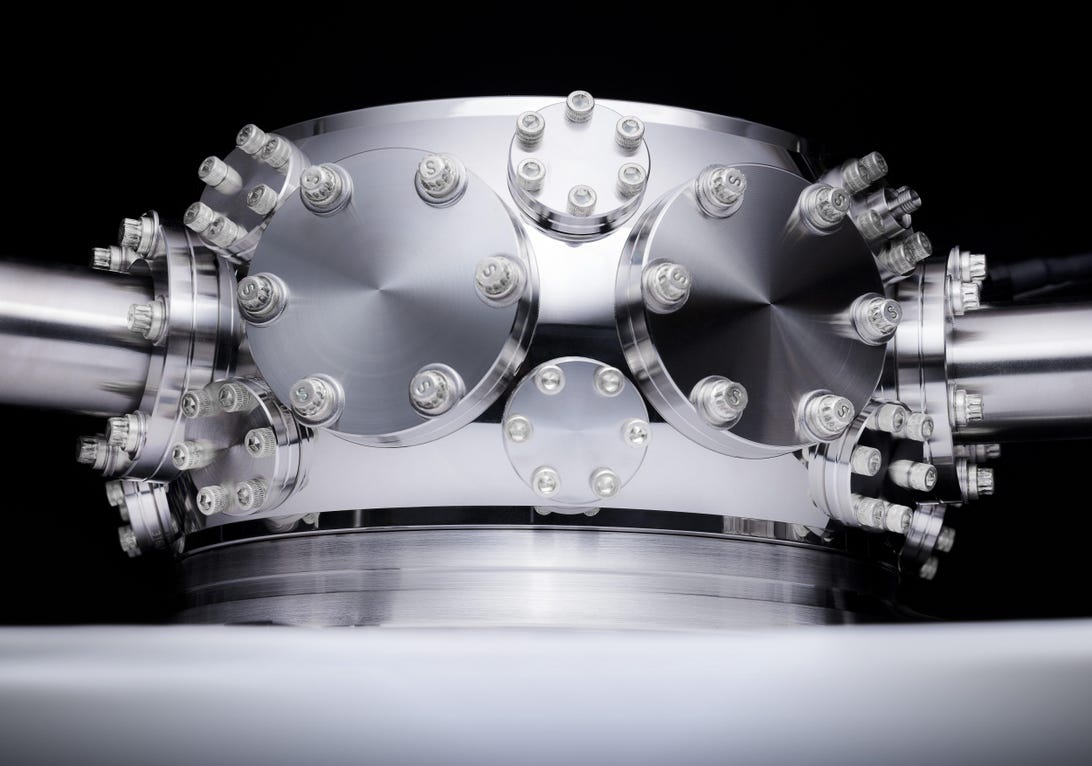Honeywell, Google bring practical quantum computers a big step closer

Honeywell’s quantum computer uses ytterbium atoms trapped in this chamber, about the size of a football, to perform computations.
Honeywell
Honeywell and Google have detailed dueling demonstrations of logical qubits, a technology that can correct errors in potentially powerful but notoriously finicky quantum computers.
In a research paper released Wednesday, Honeywell said it had ganged together multiple physical qubits — the storage and processing units of quantum computers — so that they could withstand disturbances from outside forces like vibration and electromagnetic emissions.
The results arrived one week after Google published a paper in Nature Communications also showing logical qubits overpowering errors. Google’s approach, however, didn’t achieve full error correction: its method only could handle one of two error types at a time instead of both simultaneously, and it couldn’t fix errors it detected. That’s why Honeywell is claiming its full error correction achievement as a first.
“Big enterprise-level problems require precision and error-corrected logical qubits to scale successfully,” said Tony Uttley, Honeywell Quantum Solutions’ president, in a statement.
Honeywell’s technique marks a significant step in the development of quantum computers, which have the potential to leapfrog ordinary computers in areas like materials science, manufacturing optimization and financial services. The prospect of channeling the power of quantum computers to commercial interests has triggered a gold rush as tech giants, such as Google, Intel and IBM, and startups race to develop practical machines.
Progress in the field, however, has been held back by the nature of qubits, which can be built and controlled in different ways. The trouble is all qubits can be easily perturbed, and calculations are derailed when they are. That’s why quantum computers typically run at extremely low temperatures in vibration-proof housings.
Honeywell demonstrated its technique on its 10-qubit H1 quantum computer. Seven of the qubits stored data while the remaining three “ancilla” qubits shepherded the error correction process, which is governed by a conventional computer that steers qubits back on track when a problem is detected.
Achieving quantum error correction
Quantum error correction is a method for detecting and fixing qubit errors so calculations can run longer. Different aspects of QEC, including Honeywell’s logical qubits, should enable more advanced algorithms.
Honeywell didn’t actually perform any computation during its demonstration, but showed that it could initialize the system, correct qubit errors during operations, and read the results afterward.
Using the smallest possible number of physical qubits to make a logical qubit is an important consideration in improving quantum computers. Today’s machines only have a few dozen qubits at best, and many expect quantum computers to need thousands of logical qubits to become really useful. Google said in May it expects to require about 1,000 physical qubits for each logical qubit as it moves to deliver a practical quantum computer by 2029.
Every other quantum computing company is trying to improve qubit operations, too. That work includes not just error correction, but also making qubits less prone to errors in the first place, lengthening the time multiple qubits stay entangled so they can perform calculations, and compensating for errors after calculations are complete. Even Amazon, which offers a quantum computing service called Braket but hasn’t announced any quantum computers of its own, is tackling error correction ideas.
New Honeywell quantum computers on the way
Honeywell makes quantum computers, including the H0 and H1, which uses charged atoms of ytterbium as qubits that can be manipulated with laser beams. “The H2 generation is up and running” in prototype form, Uttley said in a June interview, and the H3 is under active development.
Honeywell’s quantum computing unit is merging with Cambridge Quantum Computing, whose expertise is in algorithms and other quantum software matters.
The result, once regulatory hurdles are cleared and the deal closes, should be deeper collaboration that dramatically accelerates progress, said Ilyas Kahn, who’s CEO of Cambridge Quantum Computing and slated to take over the merged company, in June.
Also on Wednesday, Honeywell and CQC announced a new quantum computing algorithm that solves optimization problems with fewer qubits.






